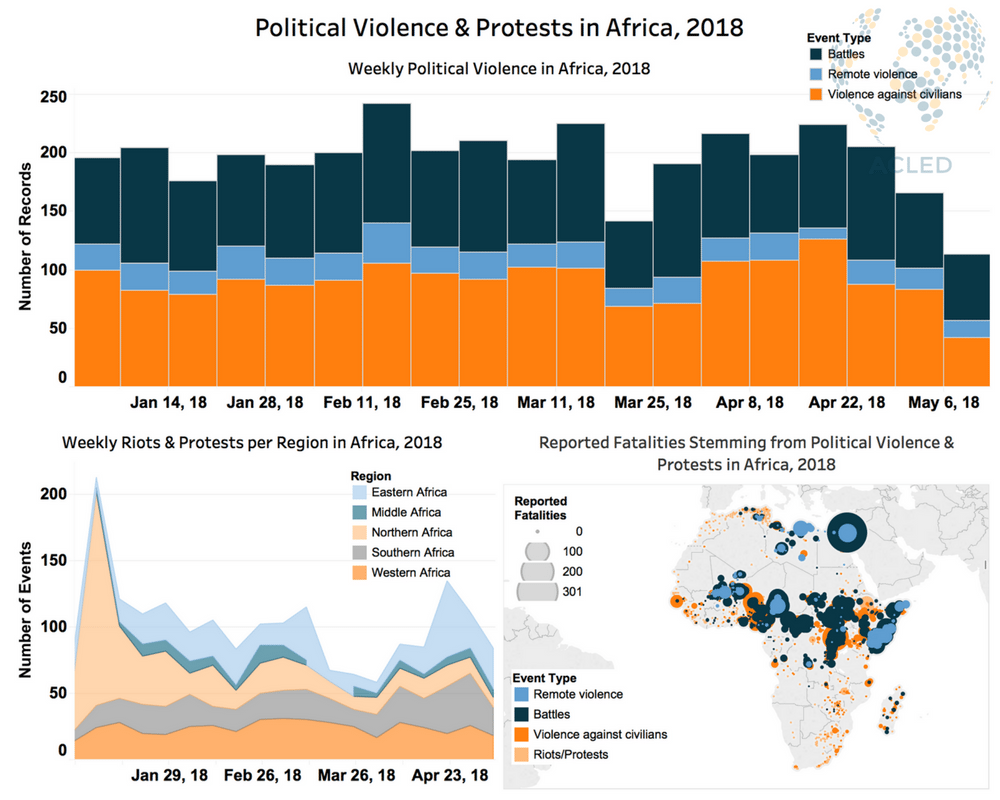Political violence and protest events in Africa over the week of May 6th showed several key developments and points of concern.
First, attacks hit Burundi and Nigeria, confirming recent warnings of an escalation of the violence in these countries. In Burundi, violence has marred the period leading up to the disputed Constitutional referendum, due to be held on May 17th. The referendum, if accepted, could authorize President Nkurunziza’s standing for a fourth term. On May 11th, in a suspected related development, thirty to forty armed men reported to have come from the Democratic Republic of Congo (DRC) attacked the Ruhagarika village in Cibitoke province, killing 26 people in their homes and setting houses on fire. Cibitoke has experienced high levels of violence in 2018. In Nigeria, hundreds of people have been recently killed in violence by Fulani militants. On May 5th, they attacked Gwaska village in Birnin Gwari Local Council of Kaduna State, killing another 71 people and razing the village altogether.
Second, Ethiopia is seeing two distinct but strongly pronounced protest movements co-occurring, with significant escalation in both. In the Somali region, protests have been ongoing since April 20th to condemn Abdi Iley’s corrupt administration and call for his resignation. The authorities have been reinforcing the Liyu forces’ presence in the region to quell the protests. In one incident on May 11th, a female human rights activist was detained and later killed by the security forces over her family’s alleged outspoken opposition to the Iley’s administration. In parallel, new protests have rocked the Oromia region, particularly the Guji district, since April 30th over the proposed extension of a license for goldmining by the MIDROC group, which has had negative health effects on the populations. The security forces also dealt violently with the demonstrations, with reports of at least 30 protesters beaten in detention. Ultimately, the protesters’ claims in Oromia were successfully met, as the goldmine group’s license was suspended.
Third, security has been boosted in several areas of Somalia and Kenya amid fears that Al Shabaab could increase its attacks during the holy month of Ramadan, starting on May 15th. In Somalia, hundreds of joint forces from the police, Intelligence and custodial corps were deployed to protect Mogadishu. They will patrol the city centers, establish checkpoints and cordon off areas where alerts are reported. In Kenya, the police issued a terror alert urging Kenyans to remain vigilant, particularly in Mandera county, where Al Shabaab has operated historically. Al Shabaab already increased its activity in Mandera lately, killing four non-Muslim quarry workers on May 3rd and laying an IED ambush on a military convoy in Daba Siti, which left one soldier dead.
Finally, the DRC continues to be one of the most active countries on the African continent, with several centres of conflict. Most notable in the last weeks has been the rising violence in Uvira in Sud-Kivu and the continued attacks by unknown gunmen stationed at the Virunga National Park in Nord-Kivu. In Uvira, there have been dozens of incidents of abductions of civilians against ransoms since April, including by various Mayi Mayi militants. Tensions appeared among the militants after the killing of one of the factions’ chief (Karakara). In early May, week-long clashes also resumed in Uvira between the Banyamulenge and Bafulero groups, amid unresolved communal tensions. In Nord-Kivu, the latest attack by unknown gunmen was on May 11th: a park ranger was killed and three people kidnapped, including two British tourists (whom were released a few days later).
AfricaAnalysisCivilians At RiskConflict MonitoringCurrent HotspotsRemote ViolenceRioting And ProtestsViolence Against Civilians






